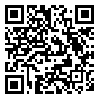Volume 15, Issue 1 And 2 (11-2011)
IBJ 2011, 15(1 And 2): 38-43 |
Back to browse issues page
Download citation:
BibTeX | RIS | EndNote | Medlars | ProCite | Reference Manager | RefWorks
Send citation to:



BibTeX | RIS | EndNote | Medlars | ProCite | Reference Manager | RefWorks
Send citation to:
Ghaffari M A, Motlagh B. In vitro Effect of Lead, Silver, Tin, Mercury, Indium and Bismuth on Human Sperm Creatine Kinase Activity: a Presumable Mechanism for Men Infertility. IBJ 2011; 15 (1 and 2) :38-43
URL: http://ibj.pasteur.ac.ir/article-1-405-en.html
URL: http://ibj.pasteur.ac.ir/article-1-405-en.html
Abstract:
Background: The aim of the present study was to investigate the in vitro effects of mercury (Hg+2), lead (Pb+2), silver (Ag+2), tin (Sn+2), bismuth (Bi+3) and indium (In+3) ions on sperm creatine kinase. Methods: creatine kinase was isolated from human sperm homogenates after chromatography on a DEAE cellulose column. Results: At 60 µg ml-1 metal concentration, 70% of the creatine kinase activity was inhibited by Hg+2, while at the same concentration, Pb+2, Ag+2, Sn+2, Bi+3 and In+3 caused 68%, 66.5%, 65.7%, 64.7% and 62.7% inhibition, respectively. All six metal ions displayed a competitive type of inhibition mechanism for the isolated creatine kinase as analyzed by Lineweaver-Burk plot. Ki values of Hg+2, Pb+2, Ag+2, Sn+2, Bi+3 and In+3 were calculated and 8.34 mM, 5 mM, 4.54 mM, 3.45 mM, 3.12 mM and 2.63 mM values were obtained, respectively. Conclusion: All the studied metal ions, at levels of 60 µg ml-1, may reduce normal sperm metabolism by inhibition of sperm creatine kinase, which probably is an important cause of infertility in men. However, further investigations, as in vitro and in vivo, are needed to elucidate the exact mechanism of heavy metals on male reproductive functioning at the molecular level.
Type of Study: Full Length/Original Article |
Subject:
Related Fields
| Rights and permissions | |
 |
This work is licensed under a Creative Commons Attribution-NonCommercial 4.0 International License. |








.png)
